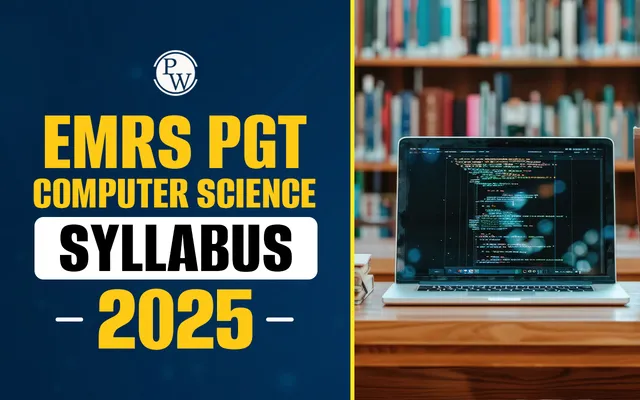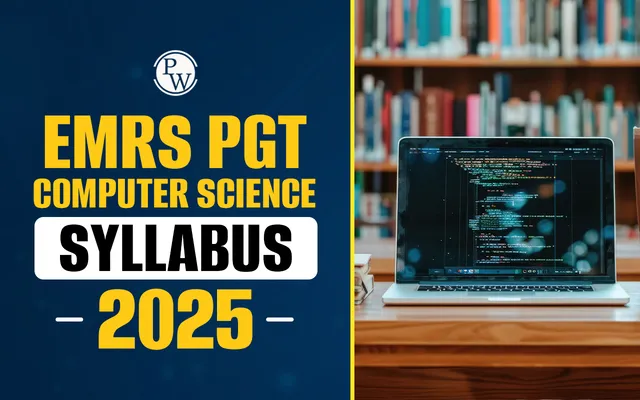

EMRS PGT Computer Science Syllabus 2025 must be prepared well by candidates who want to become Post Graduate Teachers in Computer Science under the EMRS program. This recruitment seeks skilled educators who are capable of providing education in the subject of Computer Science at the senior secondary level.
Computer Science is both conceptual and application-based. It covers programming, algorithms, databases, networking, and modern computing principles. EMRS PGT Recruitment 2025 exam evaluates candidates on both teaching aptitude and domain knowledge.
EMRS PGT Computer Science Syllabus 2025
EMRS PGT Computer Science Syllabus 2025 has been released officially under the EMRS PGT Notification 2025. Tier 1 focuses on reasoning ability, general awareness, ICT skills, and teaching aptitude. Tier 2 evaluates subject-specific knowledge.
Tier 2 ensures candidates demonstrate both theoretical understanding and practical application skills, which are important for teaching Computer Science effectively at EMRS schools. Candidates are advised to download the EMRS PGT Computer Science Syllabus PDF to plan topic-wise preparation.
EMRS PGT Computer Science Exam Pattern
EMRS PGT Computer Science Exam 2025 consists of two tiers. Tier 1 is the preliminary examination and Tier 2 is the qualifying examination. Tier 2 is the subject knowledge examination.
Tier 2 focuses on subject-specific domains. For Computer Science, objective questions test quick problem-solving and programming understanding and descriptive questions evaluate conceptual clarity, coding logic, algorithms, and the ability to explain solutions clearly.
| EMRS PGT Computer Science Exam Pattern | ||||
| Section | No. of Questions | Marks | Duration | Nature |
| Objective Questions | 40 | 40 | 180 mins | MCQs |
| Descriptive Questions | 15 | 60 | Short/Long Answers | |
EMRS PGT Computer Science Syllabus 2025 Tier 2
EMRS PGT Computer Science Syllabus 2025 Tier 2 covers all essential areas required for teaching senior secondary Computer Science. Tier 2 evaluates conceptual understanding and programming skills.
Each unit includes various sub topics which must be prepared well for Tier 2. Below is the EMRS PGT Computer Science Syllabus 2025 Tier 2:
-
Computer Systems and Organisation
-
Computational Thinking and Programming
-
Society, Law and Ethics
-
Computational Thinking and Programming – 2
-
Computer Networks
-
Database Management
-
Introduction to Computer Systems
-
Introduction to Python
-
Database concepts and the Structured Query Language
-
Emerging Trends
-
Data Handling using Pandas
-
Database Query using SQL
-
Introduction to Computer Networks
-
Societal Impacts
EMRS PGT Computer Science Syllabus PDF
EMRS PGT Computer Science Syllabus PDF provides the full syllabus for Tier 1 and Tier 2. It includes general awareness, teaching aptitude, and all subject-specific Computer Science topics.
You must download the syllabus PDF to organize your preparation, mark high-weightage topics, and practice consistently. You can use it for studying and tracking your progress. The syllabus PDF ensures complete syllabus coverage before the exam.
EMRS PGT Computer Science Exam Preparation Tips
Preparing for Tier 2 of the EMRS PGT Computer Science Exam requires a structured approach and consistent practice. Here’s how you can prepare effectively:
-
Go through the EMRS PGT Computer Science Syllabus PDF carefully. Write down all the important units like programming, data structures, networking, and databases. Prioritize topics based on the high-scoring units and its difficulty level.
-
Learn each topic conceptually and practice coding problems, algorithms, and database queries. Understand the theory along with its application to score well in descriptive or programming questions.
-
Regularly solve coding exercises in C, C++, or Java. Work on implementing data structures and algorithms to strengthen programming logic.
-
Attempt previous EMRS PGT Computer Science papers and mock tests to get used to the question pattern, manage time effectively and to understand the difficulty level. Analyze your weak areas and focus on them.
-
Create concise notes for important concepts, syntax, commands, and network diagrams. Quick revision notes help retain formulas, commands, and key definitions.
-
Tier 2 includes descriptive questions. Practice explaining your approach clearly, writing code neatly, and structuring answers logically.
